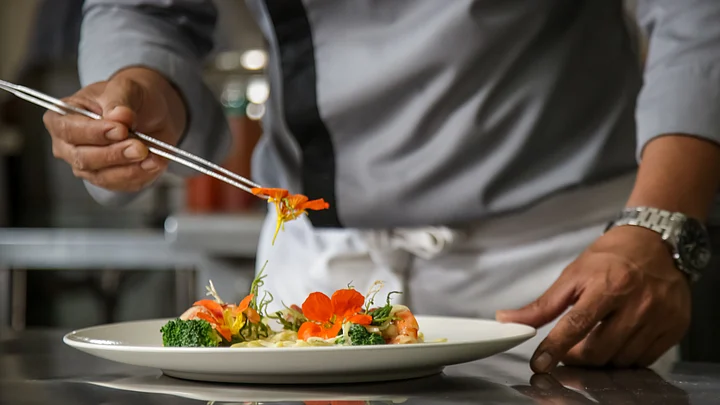I remember enjoying Agathi flower (Sesbania grandiflora) pakoras as a child. Apart from its taste, I recollect the interesting shape of the buds vividly and how I was totally intrigued by the idea of eating a flower.
Somehow with commercialisation these edible flowers have vanished from our everyday diets but are a part of the exotic fare in fancy restaurants all over the world.
A bouquet of flowers need not decorate just your home but can be served on your plate. Adding a variety of edible flowers to your diet makes it colourful and healthy.
What History Says
The consumption of flowers as food known as floriphagia is an age-old practice in many parts of the world. In India, flowers have been an integral part of our traditional cuisine since ancient times.
Marigold petals, Jasmine, local red and pink roses, and local red Hibiscus are commonly used for their medicinal properties.
They are so much a part of our food culture and tradition that we don’t even realize while consuming.
Neem flowers and leaves are fried in ghee and mixed with pepper, cumin, and sugar and offered with prasad on Gudi Padwa (New Year’s Day) in Saraswat homes.
Drumstick flowers are made into delicious fritters in Bengali homes.
Banana flowers dishes are popular in Bengal, Maharashtra, Karnataka, and Kerala.
Nutritional Benefits of Edible Flowers
Edible flowers are rich in vitamins A, and C, a good source of minerals like calcium, phosphorous, iron and potassium.
They also provide riboflavin and Niacin. Stefano Benvenuti and Marco Mazzoncini mention in an article ‘The Biodiversity of Edible Flowers: Discovering New Tastes and New Health Benefits’ that edible flowers are rich in antioxidants.
Here is a list of edible flowers you can consume.
Agathi Flower
This flower with a great taste, is rich in calcium, and cools the body. In Kerala, they make a stir-fry by chopping these flowers and quickly frying them with pearl onions, grated coconut, and green chillies.
Chopped Agathi flowers, onions, green chillies mixed with chickpea flour and wheat flour and the required seasoning can be fried into delectable fritters.
Banana Blossoms
Banana flower is widely used in cooking in many parts of India.
Rich in essential minerals such as phosphorous, calcium, potassium, copper, magnesium, and iron. It is considered a superfood.
Cleaning and cutting this flower for cooking takes some time as you need to separately clean each floret. It is used to make curries and stir-fries.
Hibiscus Flowers
Hibiscus is rich in carotene, riboflavin, ascorbic acid, niacin, calcium, iron, and vitamin C. Hibiscus tea is quite popular.
It is also used to make salads, jams, relishes and in cakes. Hibiscus can be dried and stored.
Drumstick Flowers
The drumstick tree is considered a blessing for mankind. All parts of this tree are edible from roots, bark, leaves, buds, flowers, and fruit.
Rich in calcium, potassium, Vitamin A Vitamins B1-B6, Vitamin C, D, and E it is packed with nutrition.
These flowers can be dried in shade and stored to make tea. Drumstick flowers can be added to dals, curries, chillas, salads and soups.
Slightly sauteed drumstick flowers can be added to dosa batter or rotis to increase the nutritional values.
Gongura Flowers
Gongura (Hibiscus Sabdariffa) flowers are rich in vitamin C and are great for coughs and colds.
You can make a jam by boiling the petals in water with little water to soften and then add the sugar and cook until a thick consistency is achieved. Chutney and pickles are made with these flowers.
Papaya Flowers
This flower is rich in vitamins A, C and E, dietary fibre and has antioxidant properties. It has a slightly bitter taste that imparts a unique flavour and tastes good with rice.
Sometimes it is marinated with tamarind to reduce the bitterness and then added to dishes. You can make a stir-fry with papaya flowers with potatoes.
Alternatively, cook the flowers in tamarind water with some salt. When cooked drain and keep aside.
Heat oil and sauté onion, garlic and red chilli add the papaya flowers. Add the required seasoning and cook. Serve with rice or rotis.
Lotus Flowers
This flower is considered divine and is offered to the Gods. Lotus stem (kamal kakdi) and Lotus seeds called makhane are used in many delicacies.
Lotus flowers are used to stop bleeding and are used in Ayurveda to treat diarrhoea.
Try this simple lotus flower stir fry that is made with cooked chana dal.
Ingredients
3 Lotus flowers
1 onion finely chopped
1/2 cup cooked chana dal
2 tsp ginger garlic green chilli paste
1/2 tsp turmeric powder
1/2 tsp cumin seeds
3 tbsp oil
Salt to taste
Method
Remove and discard the outer petals and the centre part of the lotus flower.Wash and chop the rest.
Heat oil. Add cumin, ginger, garlic and green chilli paste, turmeric powder and chopped onion. Sauté for a few minutes
Add the chopped Lotus flower
Add salt and cook again
Then add the cooked dal and 1/4 cup water and cover.
Cook till done. Serve with rotis.
Tips to Use Edible Flowers
1. Before consuming any flower find out if it is edible.
2. Growing edible flowers in your garden or small containers will provide organic and chemical free produce.
3. Harvesting edible flowers early in the morning is recommended.
4. Wash the flowers under running water and wipe them dry before cooking.
5. After harvesting if you aren't cooking immediately store them in a fridge in plastic containers.
6. Use edible flowers in baking, salads, syrups, teas, and garnishing
7. Freeze whole small flowers in ice cubes and add to cool drinks.
Flowers enhance nutrition and lend a natural colour to your teas, salads, and desserts. Explore the flower power to enjoy the immense health benefits.
(Nupur Roopa is a freelance writer and a life coach for mothers. She writes articles on environment, food, history, parenting, and travel.)

